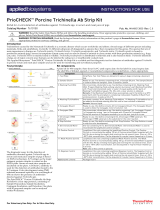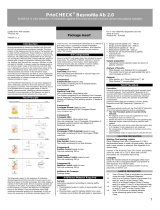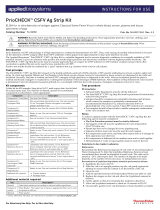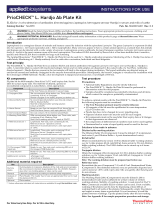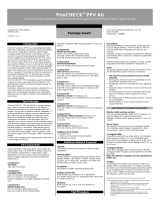Page is loading ...

For Veterinary Use Only. For In Vitro Use Only.
INSTRUCTIONS FOR USE
PrioCHECK™ Porcine HEV Ab Strip Kit
ELISA for
in vitro
detection of antibodies against hepatitis E virus in serum and meat juice of pigs
Catalog Number 4600010
Pub. No. MAN0013798 Rev. A.0
WARNING! Read the Safety Data Sheets (SDSs) and follow the handling instructions. Wear appropriate protective eyewear, clothing, and
gloves. Safety Data Sheets (SDSs) are available from thermofisher.com/support.
WARNING! POTENTIAL BIOHAZARD. Read the biological hazard safety information at this product’s page at thermofisher.com. Wear
appropriate protective eyewear, clothing, and gloves.
Introduction
Hepatitis E virus (HEV) is an emerging pathogen which primarily appears in countries, like India, Asia, Africa and Central America, causing enterically
transmitted hepatitis in human. HEV belongs to the family Hepeviridae and is a non-enveloped, icosahedral capsid containing a linear single-stranded,
positive-sense RNA with a length of approx. 7200 bases which codes for three open reading frames.
In human, acute hepatitis E is a severe illness with a comparable clinical manifestation to hepatitis A. It is usually self-limiting. During pregnancy a
fulminant course of illness develops more often, accompanied by a high mortality rate of approx. 20%. In males and non-pregnant females, the mortality
rate is 0.5%–4.0%. No incidence of chronic inflammation of hepatitis E has been reported.
In industrialized countries, HEV infections in human have long been thought to occur only in travelers to HEV endemic regions. In recent years, however,
increasing numbers of sporadic HEV infections in non-endemic regions have been reported that cannot be explained with travelling and increasing
evidence points to a transmission from domestic pigs to human.
The Applied Biosystems™ PrioCHECK™ Porcine HEV Ab Strip Kit is a reliable and fast diagnostic test for detection of antibodies against hepatitis E virus
in porcine serum and meat juice samples and can be used for monitoring and surveillance purposes.
Test principle
The PrioCHECK™ Porcine HEV Ab Strip Kit for
the detection of antibodies directed against
hepatitis E virus in porcine serum and meat juice
samples is based on ELISA technology.
The PrioCHECK™ Porcine HEV Ab Strip Kit
follows a four step protocol, consisting of Sample
Preparation, Sample Incubation, Conjugate
Incubation and Detection.
Recombinant hepatitis E virus (HEV) antigen of
the open reading frame (ORF) ORF 2 and ORF 3
of the genotypes 1 and 3 is coated on the ELISA
plate. Serum or meat juice samples are incubated
on the plate. A peroxidase (POD) labeled anti-pig
antibody is used for the detection of antibodies
bound to the recombinant HEV antigens. Color
development using TMB substrate measured
optically at a wavelength of 450 nm shows the
presence of antibodies directed against HEV.
One plate with 90 prepared samples can be
analyzed within 150 minutes.
Kit components
5 strip plate kit for 450 samples. Store kit at 5±3°C until expiry date. See kit label for actual expiry date.
The shelf life of diluted, opened or reconstituted components is noted below, where appropriate.
Component
Description
1: Test Plate
Strip Plate. Five Test Plates are delivered in vacuum bags containing a desiccant bag.
2: Dilution Buffer
Ready-to-use. Three bottles, each containing 60 mL of Dilution Buffer. The Dilution
Buffer is used to dilute the samples and conjugate. Color of solution: blue
3: Washing Fluid (10x)
10x concentrate, dilute before use. Four bottles, each containing 60 mL Washing
Fluid (10x). Prepare Washing Fluid working solution by mixing 1 part Washing
Fluid (10x) with 9 parts demineralized water or water of equal quality. Mix until a
clear solution is obtained. See Appendix A.
Stability of Wash Fluid working solution:
• 4 weeks at 5±3°C.
• 1 week at 22±3°C.
4: Conjugate (100x)
100x concentrate, dilute before use. One vial contains 1.3 mL Conjugate (100x).
Prepare Conjugate working solution by mixing 1 part of Conjugate (100x) with
99 parts of Dilution Buffer. Dilute the amount of Conjugate necessary to run the
test, just prior to use. See Appendix A.
5: Positive Control
Ready-to-use. One vial contains 750 µL Positive Control. Black lid.
6: Cut-off Control
Ready-to-use. One vial contains 750 µL Cut-off Control. Grey lid.
7: Negative Control
Ready-to-use. One vial contains 750 µL Negative Control. White lid.
8: Chromogen (TMB) Substrate
Ready-to-use. One bottle containing 60 mL Chromogen (TMB) Substrate. The
Chromogen (TMB) Substrate is the substrate for the color reaction.
9: Stop Solution
Ready-to-use. One bottle containing 60 mL Stop Solution. The Stop Solution is
used to stop the color development.
Additional kit contents
• Package Insert
• Sealing films
Additional material required
Use
Description(1)
General
Laboratory equipment according to national safety regulations.
• Demineralized water or water of equal quality must be used
• Dummy plate, used for sample dilution (e.g. clear colorless round bottom 96 well plates) or
equivalent; non-binding
• Single channel pipettes and multi-channel pipettes suitable to pipette the required volumes
• Pipette tips (as recommended by pipette manufacturer)
• Solution reservoirs
• Vortex
Sample
preparation
• Dedicated blood collection tubes
• Dedicated meat juice collection tubes
Analysis of
results
Plate Reader, e.g. Tecan Sunrise or equivalent. The reader has to have an appropriate filter set
to read the plates at 450 nm (Reference 620 nm).
Optional
Plate washer.
(1) Unless otherwise indicated, all materials are available through thermofisher.com.

2 PrioCHECK™ Porcine HEV Ab Strip Kit Instructions for Use
Test procedure
Precautions
• National Safety Regulations must be strictly followed.
• The PrioCHECK™ Porcine HEV Ab Strip Kit must be performed in
laboratories suited for this purpose.
• Samples should be considered as potentially infectious and all items
which contact the samples as potentially contaminated.
Notes
To achieve optimal results with the PrioCHECK™ Porcine HEV Ab Strip
Kit, the following aspects must be considered:
• The test procedure must be strictly followed.
• Pipette tips have to be changed for every pipetting step.
• Separate solution reservoirs must be used for each reagent.
• Kit components must not be used after their expiry date or if changes
in their appearance are observed.
• Kit components of different kit lot numbers must not be used together.
• Demineralized water or equal must be used for the test.
Sample preparation
• Serum can be obtained using standard methods.
• If meat juice is tested, a piece of muscle tissue e.g. 10 g is either freeze-
thawed in a dedicated device or alternatively the piece of meat can be
squeezed to obtain meat juice.
• Heat inactivated samples may lead to an increased background and
are therefore not recommended to be used.
Sample dilution for serum samples
Serum samples are diluted 1:100, controls 1:100.
1. Use a Dummy Plate or equivalent for first sample dilution.
2. Add 10 µL of Positive Control to wells A1 and B1 of the Dummy Plate.
3. Add 10 µL of Cut-off Control to wells C1 and D1 of the Dummy Plate.
4. Add 10 µL of Negative Control to wells E1 and F1 of the Dummy Plate.
5. Add 10 µL of serum samples to the remaining wells of the Dummy
Plate.
6. Add 90 µL of Dilution Buffer to each well of the Dummy Plate and mix
by pipetting up and down 5 times.
7. Add 90 µL of Dilution Buffer to each well of the Test Plate.
8. Transfer 10 µL of the diluted samples and controls from the Dummy
Plate to the Test Plate and mix by pipetting up and down 5 times.
Sample dilution for meat juice samples
Meat juice samples are diluted 1:10, controls 1:100.
1. Use a Dummy Plate or equivalent for first sample dilution.
2. Add 10 µL of Positive Control to wells A1 and B1 of the Dummy Plate.
3. Add 10 µL of Cut-Off Control to wells C1 and D1 of the Dummy Plate.
4. Add 10 µL of Negative Control to wells E1 and F1 of the Dummy Plate.
5. Add 90 µL of Dilution Buffer to wells containing controls A1 to F1 of
the Dummy Plate.
6. Add 100 µL of meat juice samples to the remaining wells of the
Dummy Plate.
7. Provide 90 µL of Dilution Buffer to all wells of the Test Plate.
8. Transfer 10 µL of meat juice samples and diluted controls from the
Dummy Plate to the Test Plate and mix by pipetting up and down
5 times.
Sample incubation
1. Carefully tape over the Test Plate with an unused sealing film.
2. Incubate the samples on the Test Plate for 60±1 minutes at 37±3°C.
3. Wash the Test Plate four times with 300 µL Wash Fluid working
solution (see Appendix A).
4. Tap the plate over a paper towel to remove any residual liquid from
the wells.
Conjugate incubation
Preparatory steps
Dilute the needed amount of Conjugate (100x) 100 fold in Dilution Buffer
(e.g. add 100 µL Conjugate to 9.9 mL Dilution Buffer for one full plate; see
Appendix A).
Conjugate incubation
1. Add 100 µL of the diluted Conjugate to each well of the Test Plate.
2. Carefully tape over the Test Plate with an unused sealing film.
3. Incubate the Test Plate for 30±1 minutes at 37±3°C.
4. Wash the Test Plate four times with 300 µL Wash Fluid working
solution (see Appendix A).
5. Tap the plate over a paper towel to remove any residual liquid from
the wells.
Detection
Substrate reaction
1. Add 100 µL of the Chromogen (TMB) Substrate to each well on the
Test Plate.
2. Incubate the Test Plate for 30±1 minutes at 22±3°C.
3. Add 100 µL of the Stop Solution to each well of the Test Plate.
Remark: Add the Stop Solution in the same order and time as the
Chromogen (TMB) Substrate solution was dispensed.
Note: The color of the Positive Controls will change from blue to yellow.
Detection
1. Shake the Test Plate shortly (5–10 s) either on an orbital shaker
(~300 rpm) or manually on the working bench.
2. Read the Test Plate in the ELISA reader at 450 nm within 60 minutes.
Recommendation: Use a reference filter at 620 nm.
Result interpretation
Validation criteria
1. The mean OD450 of the Positive Controls minus the OD450 of the Cut-off
Control must be ≥0.3.
2. The mean OD450 of the Cut-off Control minus the OD450 of the negative
control must be ≥0.05.
3. The mean OD450 of the Negative Controls must be <0.15.
If these criteria are not met, the results are invalid and the plate has to be
retested.
Cut-off calculation
The Cut-off is calculated as mean OD450 of the Cut-off Control multiplied
with 1.2.
mean OD450 of Cut-off Control × 1.2 = cut-off
Interpretation of results
• Results obtained above or equal to the cut-off are considered positive.
• Results between the OD450 of the Cut-off Control and the cut-off (see
calculation above) are doubtful and it is recommended to retest those
samples. If they remain in the doubtful are, a second sample taken at a
later time point should be taken and tested.
• Results obtained below the cut-off are negative.

thermofisher.com/support | thermofisher.com/askaquestion
thermofisher.com
27 November 2017
Appendix A - Preparation of Washing Fluid working solution
and Conjugate solution
Washing Fluid working solution
Mix indicated volumes of demineralized water and Washing Fluid (10x)
and mix properly to obtain the desired volume of Washing Fluid working
solution.
• Transfer 100 mL Washing fluid (10x) to a 1 L bottle.
• Add 900 mL of demineralized water and mix.
Volume Washing Fluid
working solution
=
Amount of Washing
Fluid (10x)
+
Amount of
demineralized water
0.3 L
=
30 mL
+
270 mL
0.5 L
=
50 mL
+
450 mL
1.0 L
=
100 mL
+
900 mL
2.0 L
=
200 mL
+
1800 mL
Conjugate working solution
Mix indicated volumes of Conjugate (100x) with the appropriate amount
of Dilution Buffer (supplied with the kit) to obtain the desired amount of
Conjugate.
No. of plates
Conjugate needed
=
Conjugate (100x)
+
Dilution Buffer
1
12 mL
=
0.12 mL
+
11.88 mL
2
24 mL
=
0.24 mL
+
24.78 mL
3
36 mL
=
0.36 mL
+
35.64 mL
4
48 mL
=
0.48 mL
+
47.52 mL
5
60 mL
=
0.60 mL
+
59.40 mL
Appendix B - Pipetting schemes
Recommended pipetting scheme for Dummy Plate and Test Plate.
Customer and technical support
Technical support: visit thermofisher.com/askaquestion
Visit thermofisher.com/support for the latest in services and support,
including:
• Worldwide contact telephone numbers
• Order and web support
• User guides, manuals, and protocols
• Certificates of Analysis
• Safety Data Sheets (SDSs; also known as MSDSs)
NOTE: For SDSs for reagents and chemicals from other manufacturers,
contact the manufacturer.
Limited product warranty
Life Technologies Corporation and/or its affiliate(s) warrant their
products as set forth in the Life Technologies' General Terms and
Conditions of Sale found on Life Technologies' website at
www.thermofisher.com/us/en/home/global/terms-and-conditions.html.
If you have any questions, please contact Life Technologies at
thermofisher.com/support.
Prionics Lelystad B.V. | Platinastraat 33 | 8211 AR Lelystad | The Netherlands
The information in this guide is subject to change without notice.
DISCLAIMER: TO THE EXTENT ALLOWED BY LAW, LIFE TECHNOLOGIES AND/OR ITS AFFILIATE(S)
WILL NOT BE LIABLE FOR SPECIAL, INCIDENTAL, INDIRECT, PUNITIVE, MULTIPLE, OR
CONSEQUENTIAL DAMAGES IN CONNECTION WITH OR ARISING FROM THIS DOCUMENT,
INCLUDING YOUR USE OF IT.
Revision history of Pub. No. MAN0013798 (English)
Rev.
Date
Description
A.0 27 November
2017
New document. Converted the legacy document (MAN0013798
HEV_ELISA_PI_v1.0_e_111223.doc) to the current document template,
with associated updates to the publication number, limited license
information, warranty, trademarks, and logos.
Important Licensing Information: These products may be covered by one or more Limited Use
Label Licenses. By use of these products, you accept the terms and conditions of all applicable
Limited Use Label Licenses.
©2017 Thermo Fisher Scientific Inc. All rights reserved. All trademarks are the property of Thermo
Fisher Scientific and its subsidiaries unless otherwise specified.
12345678910 11 12
A
Positive
Control
Sample
3
Sample
11
Sample
19
Sample
27
Sample
35
Sample
43
Sample
51
Sample
59
Sample
67
Sample
75
Sample
83
B
Positive
Control
Sample
4
Sample
12
Sample
20
Sample
28
Sample
36
Sample
44
Sample
52
Sample
60
Sample
68
Sample
76
Sample
84
C
Cut-Off
Control
Sample
5
Sample
13
Sample
21
Sample
29
Sample
37
Sample
45
Sample
53
Sample
61
Sample
69
Sample
77
Sample
85
D
Cut-Off
Control
Sample
6
Sample
14
Sample
22
Sample
30
Sample
38
Sample
46
Sample
54
Sample
62
Sample
70
Sample
78
Sample
86
E
Negative
Control
Sample
7
Sample
15
Sample
23
Sample
31
Sample
39
Sample
47
Sample
55
Sample
63
Sample
71
Sample
79
Sample
87
F
Negative
Control
Sample
8
Sample
16
Sample
24
Sample
32
Sample
40
Sample
48
Sample
56
Sample
64
Sample
72
Sample
80
Sample
88
G
Sample
1Sample
9
Sample
17
Sample
25
Sample
33
Sample
41
Sample
49
Sample
57
Sample
65
Sample
73
Sample
81
Sample
89
H
Sample
2
Sample
10
Sample
18
Sample
26
Sample
34
Sample
42
Sample
50
Sample
58
Sample
66
Sample
74
Sample
82
Sample
90
/
